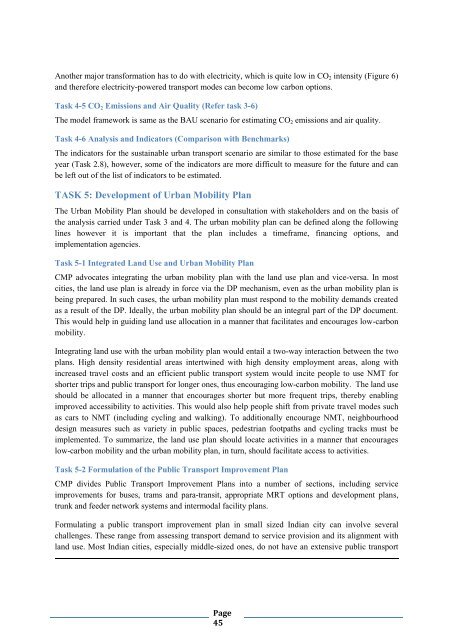Toolkits for Urban Transport Development - UNEP
Toolkits for Urban Transport Development - UNEP
Toolkits for Urban Transport Development - UNEP
You also want an ePaper? Increase the reach of your titles
YUMPU automatically turns print PDFs into web optimized ePapers that Google loves.
Another major trans<strong>for</strong>mation has to do with electricity, which is quite low in CO 2 intensity (Figure 6)<br />
and there<strong>for</strong>e electricity-powered transport modes can become low carbon options.<br />
Task 4-5 CO 2 Emissions and Air Quality (Refer task 3-6)<br />
The model framework is same as the BAU scenario <strong>for</strong> estimating CO 2 emissions and air quality.<br />
Task 4-6 Analysis and Indicators (Comparison with Benchmarks)<br />
The indicators <strong>for</strong> the sustainable urban transport scenario are similar to those estimated <strong>for</strong> the base<br />
year (Task 2.8), however, some of the indicators are more difficult to measure <strong>for</strong> the future and can<br />
be left out of the list of indicators to be estimated.<br />
TASK 5: <strong>Development</strong> of <strong>Urban</strong> Mobility Plan<br />
The <strong>Urban</strong> Mobility Plan should be developed in consultation with stakeholders and on the basis of<br />
the analysis carried under Task 3 and 4. The urban mobility plan can be defined along the following<br />
lines however it is important that the plan includes a timeframe, financing options, and<br />
implementation agencies.<br />
Task 5-1 Integrated Land Use and <strong>Urban</strong> Mobility Plan<br />
CMP advocates integrating the urban mobility plan with the land use plan and vice-versa. In most<br />
cities, the land use plan is already in <strong>for</strong>ce via the DP mechanism, even as the urban mobility plan is<br />
being prepared. In such cases, the urban mobility plan must respond to the mobility demands created<br />
as a result of the DP. Ideally, the urban mobility plan should be an integral part of the DP document.<br />
This would help in guiding land use allocation in a manner that facilitates and encourages low-carbon<br />
mobility.<br />
Integrating land use with the urban mobility plan would entail a two-way interaction between the two<br />
plans. High density residential areas intertwined with high density employment areas, along with<br />
increased travel costs and an efficient public transport system would incite people to use NMT <strong>for</strong><br />
shorter trips and public transport <strong>for</strong> longer ones, thus encouraging low-carbon mobility. The land use<br />
should be allocated in a manner that encourages shorter but more frequent trips, thereby enabling<br />
improved accessibility to activities. This would also help people shift from private travel modes such<br />
as cars to NMT (including cycling and walking). To additionally encourage NMT, neighbourhood<br />
design measures such as variety in public spaces, pedestrian footpaths and cycling tracks must be<br />
implemented. To summarize, the land use plan should locate activities in a manner that encourages<br />
low-carbon mobility and the urban mobility plan, in turn, should facilitate access to activities.<br />
Task 5-2 Formulation of the Public <strong>Transport</strong> Improvement Plan<br />
CMP divides Public <strong>Transport</strong> Improvement Plans into a number of sections, including service<br />
improvements <strong>for</strong> buses, trams and para-transit, appropriate MRT options and development plans,<br />
trunk and feeder network systems and intermodal facility plans.<br />
Formulating a public transport improvement plan in small sized Indian city can involve several<br />
challenges. These range from assessing transport demand to service provision and its alignment with<br />
land use. Most Indian cities, especially middle-sized ones, do not have an extensive public transport<br />
Page<br />
45
















